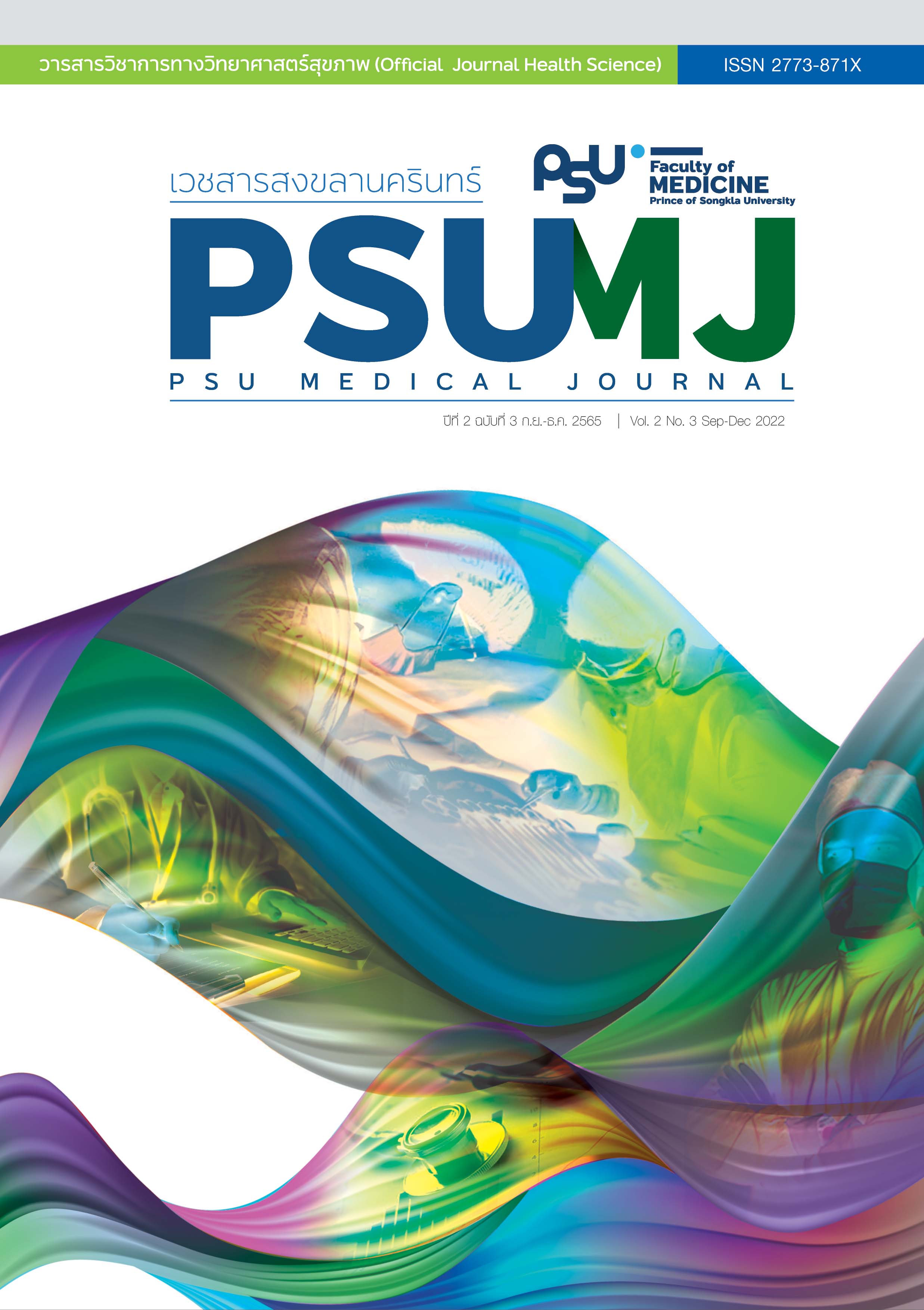Neurobiology of Attention Deficit Hyperactivity Disorder
Neurobiology of Attention Deficit Hyperactivity Disorder
DOI:
https://doi.org/10.31584/psumj.2022252616Keywords:
ADHD, neurobiology, geneticsAbstract
Factor of neurobiology ADHD consisted of several factors; such as, mutation of genes, disequilibrium of dopamine levels, and both structural and functional abnormalities of the brain. Even the smallest change in gene mutation can cause more complex problems; thus, the factor of neurobiology ADHD is one important cause that impacts ADHD children; such as, psychosocial and environmental factors. Presently, technologies have become more helpful in research. The limitations of this study included that only free access papers were included, and that the, diagnosis in DSM V were used as search terms instead of ICD system, because of up-to-date popularity. Hence, there might have been some data missed via this searching strategy. Therefore, further studies should include these in the future.
References
Sayal K, Prasad V, Daley D, Ford T, Coghill D. ADHD in children and young people: prevalence, care pathways, and service provision. Lancet Psychiatry 2018;5:175-86.
Polanczyk G, de Lima MS, Horta BL, Biederman J, Rohde LA. The worldwide prevalence of ADHD: a systematic review and metaregression analysis. Am J Psychiatry 2007;164:942-8.
Benjasuwantep B, Ruangdaraganon N, Visudhiphan P. Prevalence and clinical characteristics of attention deficit hyperactivity disorder among primary school students in Bangkok. J Med Assoc Thai 2002;85:1232-40.
Visanuyothin T, Pavasuthipaisit C, Wachiradilok P, Arunruang P, Buranasuksakul T. The prevalence of attention deficit/ hyperactivity disorder in Thailand. J Ment Heal Thai 2013;21:65–75.
Katzman MA, Bilkey TS, Chokka PR, Fallu A, Klassen LJ. Adult ADHD and comorbid disorders: Clinical implications of a dimensional approach. BMC Psychiatry 2017;17:1–15.
Kooij JJS, Huss M, Asherson P, Akehurst R, Beusterien K, French A, et al. Distinguishing comorbidity and successful management of adult ADHD. J Atten Disord 2012;16(Suppl 5):S3-19.
Chanvit P. Attention deficit hyperactive disorders. 2nd ed. Bangkok: Faculty of Medicine Siriraj Hospital; 2019;p59–70.
Huang L, Wang Y, Zhang L, Zheng Z, Zhu T, Qu Y, et al. Maternal smoking and attention-deficit/hyperactivity disorder in offspring: a meta-analysis. Pediatrics 2018;141:e20172465.
Stevens SE, Sonuga-Barke EJS, Kreppner JM, Beckett C, Castle J, Colvert E, et al. Inattention/overactivity following early severe institutional deprivation: presentation and associations in early adolescence. J Abnorm Child Psychol 2008;36:385–98.
Mick E, Biederman J, Faraone S V, Sayer J, Kleinman S. Case-control study of attention-deficit hyperactivity disorder and maternal smoking, alcohol use, and drug use during pregnancy. J Am Acad Child Adolesc Psychiatry 2002;41:378- 85.
Linnet KM, Dalsgaard S, Obel C, Wisborg K, Henriksen TB, Rodriguez A, et al. Maternal lifestyle factors in pregnancy risk of attention deficit hyperactivity disorder and associated behaviors: review of the current evidence. Am J Psychiatry 2003;160:1028-40.
Talge NM, Neal C, Glover V. Antenatal maternal stress and long-term effects on child neurodevelopment: how and why? J Child Psychol Psychiatry Allied Discip 2007;48:245–61.
Braun JM, Kahn RS, Froehlich T, Auinger P, Lanphear BP. Exposures to environmental toxicants and attention deficit hyperactivity disorder in U.S. children. Environ Health Perspect 2006;114:1904–9.
Tsao PC, Lee YS, Jeng MJ, Hsu JW, Huang KL, Tsai SJ, et al. Additive effect of congenital heart disease and early developmental disorders on attention-deficit/hyperactivity disorder and autism spectrum disorder: a nationwide population-based longitudinal study. Eur Child Adolesc Psychiatry 2017;26:1351–9.
Max JE, Lansing AE, Koele SL, Castillo CS, Bokura H, Schachar R, et al. Attention deficit hyperactivity disorder in children and adolescents following traumatic brain injury. Dev Neuropsychol 2004;25:159–77.
Levin H, Hanten G, Max J, Li X, Swank P, Ewing-Cobbs L, et al. Symptoms of attention-deficit/hyperactivity disorder following traumatic brain injury in children. J Dev Behav Pediatr 2007;28:108–18.
Yang LY, Huang CC, Chiu WT, Huang LT, Lo WC, Wang JY. Association of traumatic brain injury in childhood and attention-deficit/hyperactivity disorder: a population-based study. Pediatr Res 2016;80:356–62.
Johnston C, Mash EJ, Miller N, Ninowski JE. Parenting in adults with attention-deficit/hyperactivity disorder (ADHD). Clin Psychol Rev 2012;32:215-28.
Larsson H, Chang Z, D’Onofrio BM, Lichtenstein P. The heritability of clinically diagnosed attention deficit hyperactivity disorder across the lifespan. Psychol Med 2014;44:2223–9.
Faraone SV, Perlis RH, Doyle AE, Smoller JW, Goralnick JJ, Holmgren MA, et al. Molecular genetics of attention-deficit/ hyperactivity disorder. Biol Psychiatry 2005;57:1313–23.
Willcutt EG, Pennington BF, DeFries JC. Twin study of the etiology of comorbidity between reading disability and attention-deficit/hyperactivity disorder. Am J Med Genet - Neuropsychiatr Genet 2000;96:293–301.
Cortese S. The neurobiology and genetics of attention-deficit/ hyperactivity disorder (ADHD): what every clinician should know. Eur J Paediatr Neurol 2012;16:422-33.
Faraone S V, Doyle AE, Mick E, Biederman J. Meta-analysis of the association between the 7-repeat allele of the dopamine D4 receptor gene and attention deficit hyperactivity disorder. Am J Psychiatry 2001;158:1052–7.
XIN LI XUE BAO. An overview of the genetics of ADHD. United KIngdom. Europe PMC Funders Group 2008;40:1088–98.
Li D, Sham PC, Owen MJ, He L. Meta-analysis shows significant association between dopamine system genes and attention deficit hyperactivity disorder (ADHD). Hum Mol Genet 2006;15:2276–84.
Curran S, Mill J, Turanli ET, Kent L, Richards S, Gould A, et al. Association study of a dopamine transporter polymorphism and attention deficit hyperactivity disorder in UK and Turkish samples. Molecular Psychiatry 2001;425–8.
Rommelse NNJ, Altink ME, Arias-Vásquez A, Buschgens CJM, Fliers E, Faraone S V, et al. A review and analysis of the relationship between neuropsychological measures and DAT1 in ADHD. Am J Med Genet Part B Neuropsychiatr Genet 2008;147:1536–46.
Cheuk DKL, Wong V. Meta-analysis of association between a catechol-O-methyltransferase gene polymorphism and attention deficit hyperactivity disorder. Behav Genet 2006;36:651–9.
Thapar A, Langley K, Fowler T, Rice F, Turic D, Whittinger N, et al. Catechol O-methyltransferase gene variant and birth weight predict early-onset antisocial behavior in children with attention-deficit/hyperactivity disorder. Arch Gen Psychiatry 2005;62:1275–8.
Walter AM, Wiederhold K, Bruns D, Fasshauer D, Sørensen JB. Synaptobrevin N-terminally bound to syntaxin-SNAP-25 defines the primed vesicle state in regulated exocytosis. J Cell Biol 2010;188:401–13.
Feng Y, Crosbie J, Wigg K, Pathare T, Ickowicz A, Schachar R, et al. The SNAP25 gene as a susceptibility gene contributing to attention-deficit hyperactivity disorder. Mol Psychiatry 2005;10:998–1005.
Stephen M.Stahl. stahl’s essential psychopharmacology. New York: Cambridge University Press; 2013.489–520p.
Tripp G, Wickens JR. Neurobiology of ADHD. Neuropharmacology 2009;57:579-89.
Luman M. Identifying the neurobiology of altered reinforcement sensitivity in ADHD: a review and research agenda. Neurosci Biobehav Rev 2010;34:744–54.
Sagvolden T. A dynamic developmental theory of attention-deficit/hyperactivity disorder (ADHD) predominantly hyperactive/impulsive and combined subtypes. Behav Brain Sci 2005;28:397–468.
Johansen EB, Aase H, Meyer A, Sagvolden T. Attention-deficit/hyperactivity disorder (ADHD) behaviour explained by dysfunctioning reinforcement and extinction processes. Behav Brain Res 2002;130:37–45.
Aase H, Sagvolden T. Moment-to-moment dynamics of ADHD behaviour. Behav Brain Funct 2005;1:1–14.
Tripp G, Wickens JR. Research review: Dopamine transfer deficit: a neurobiological theory of altered reinforcement mechanisms in ADHD. J Child Psychol Psychiatry Allied Discip 2008;49:691–704.
Luman M, Tripp G, Scheres A. Identifying the neurobiology of altered reinforcement sensitivity in ADHD: a review and research agenda. Neurosci Biobehav Rev 2010;34:744-54.
Levy F. Dopamine vs noradrenaline: Inverted-U effects and ADHD theories. Aust N Z J Psychiatry 2009;43:101–8.
Arnsten AFT. The emerging neurobiology of attention deficit hyperactivity disorder: the key role of the prefrontal association cortex. J Pediatr 2009;154:I-S43.
Cools R, D’Esposito M. Inverted-U-shaped dopamine actions on human working memory and cognitive control. Biol Psychiatry 2011;69:113-25.
Ellison-Wright I, Ellison-Wright Z, Bullmore E. Structural brain change in attention deficit hyperactivity disorder identified by meta-analysis. BMC Psychiatry 2008;8:1–8.
Shaw P, Eckstrand K, Sharp W, Blumenthal J, Lerch JP, Greenstein D, et al. Attention-deficit/hyperactivity disorder is characterized by a delay in cortical maturation. Proc Natl Acad Sci USA 2007;104:19649-54.
Shaw P, De Rossi P, Watson B, Wharton A, Greenstein D, Raznahan A, et al. Mapping the development of the basal ganglia in children with attention-deficit/hyperactivity disorder. J Am Acad Child Adolesc Psychiatry 2014;53:780-9.
Castellanos FX, Lee PP, Sharp W, Jeffries NO, Greenstein DK, Clasen LS, et al. Developmental trajectories of brain volume abnormalities in children and adolescents with attention-deficit/ hyperactivity disorder. J Am Med Assoc 2002;288:1740–8.
Valera EM, Faraone SV, Murray KE, Seidman LJ. Meta-analysis of structural imaging findings in attention-deficit/ hyperactivity disorder. Biol Psychiatry 2007;61:1361–9.
Robbins TW. Shifting and stopping: fronto-striatal substrates, neurochemical modulation and clinical implications. Philos Trans R Soc Lond B Biol Sci 2007;362:917–32.
Pollmann S. Anterior prefrontal contributions to implicit attention control. Brain Sci 2012;2:254–66.
Halperin JM, Schulz KP. Revisiting the role of the prefrontal cortex in the pathophysiology of attention-deficit/hyperactivity disorder. Psychol Bull 2006;132:560–81.
Christiansen H, Hirsch O, Albrecht B, Chavanon ML. Attention-deficit/hyperactivity disorder (ADHD) and emotion regulation over the life span. Curr Psychiatry Rep 2019;21:16–8.
Peers PV, Simons JS, Lawrence AD. Prefrontal control of attention to threat. Front Hum Neurosci 2013;7:1–12.
Chiang HL, Hsu YC, Shang CY, Tseng WYI, Gau SSF. White matter endophenotype candidates for ADHD: a diffusion imaging tractography study with sibling design. Psychol Med 2020;50:1203–13.
Weele CMV, Siciliano CA, Tye KM. Dopamine tunes prefrontal outputs to orchestrate aversive processing. Brain Res 2019;1713:16-31.
Mehta TR, Monegro A, Nene Y. Fayyaz M, Bollu PC. Neurobiology of ADHD: a review. Curr Dev Disord Rep 2019;6:235-40.
Aylward EH, Reiss AL, Reader MJ, Singer HS, Brown JE, Denckla MB. Basal ganglia volumes in children with attention-deficit hyperactivity disorder. J Child Neurol 1996;11:112–5.
Somnuek N. Neurology system and function. 2nd ed. Bangkok: Cypress; 2013;66-205.
Goetz M, Vesela M, Ptacek R. Notes on the role of the cerebellum in ADHD. Austin J Psychiatry Behav Sci 2014;1:1013.
Bledsoe JC, Semrud-Clikeman M, Pliszka SR. Neuroanatomical and neuropsychological correlates of the cerebellum in children with attention-deficit/hyperactivity disorder-combined type. J Am Acad Child Adolesc Psychiatry 2011;50:593–601.
Rolls ET. The cingulate cortex and limbic systems for action, emotion, and memory. Handb Clin Neurol 2019;166:23–37.
Nagy GA, Cernasov P, Pisoni A, Walsh E, Dichter GS, Smoski MJ. Reward network modulation as a mechanism of change in behavioral activation. Behav Modif 2020;44:186–213.
Galtress T, Kirkpatrick K. The role of the nucleus accumbens core in impulsive choice, timing, and reward processing. Behav Neurosci 2010;124:26–43.
Volkow ND, Wang GJ, Newcorn JH, Kollins SH, Wigal TL, Telang F, et al. Motivation deficit in ADHD is associated with dysfunction of the dopamine reward pathway. Mol Psychiatry 2011;16:1147–54.
Vestberg T, Reinebo G, Maurex L, Ingvar M, Petrovic P. Core executive functions are associated with success in young elite soccer players. PLoS One 2017;12:1–13.
Griffin JA, McCardle P, Freund LS. Executive Function in preschool-age children: integrating measurement, neurodevelopment, and translational research. Washington,DC: American Psychological Association; 2016.
Nestler E, Hyman S, Holtzman D, Malenka R. Molecular neuropharmacology: a foundation for clinical neuroscience, 3e. 3rd ed. New York: McGraw-Hill Medical; 2009;p155–7.
Thai Health Promotion Foundation. Executive function for success. In: Executive function children 7-12 years old for parents and teachers. RLG; 2018.
Hosenbocus S, Chahal R. A review of executive function deficits and pharmacological management in children and adolescents. J Can Acad Child Adolesc Psychiatry 2012;21:223–9.
Swanson JM. Role of executive function in ADHD. J Clin Psychiatry 2003;64:35–9.
Diamond A. Executive functions. Annu Rev Psychol 2013;64:135–68.
von Rhein D, Beckmann CF, Franke B, Oosterlaan J, Heslenfeld DJ, Hoekstra PJ, et al. Network-level assessment of reward-related activation in patients with ADHD and healthy individuals. Hum Brain Mapp 2017;38:2359–69.
Buckner RL, Andrews-Hanna JR, Schacter DL. The brain’s default network: Anatomy, function, and relevance to disease. Ann N Y Acad Sci 2008;1124:1–38.
Uddin LQ; Yeo BT, Spreng RN. Towards a universal taxonomy of macro-scale functional human brain network. Brain Topogr 2019;6:926–42.
Mills BD, Miranda-Dominguez O, Mills KL, Earl E, Cordova M, Painter J, et al. ADHD and attentional control: Impaired segregation of task positive and task negative brain networks. Netw Neurosci 2018;2:200–17.
Downloads
Published
How to Cite
Issue
Section
License
Copyright (c) 2022 Author and Journal

This work is licensed under a Creative Commons Attribution-NonCommercial-NoDerivatives 4.0 International License.








